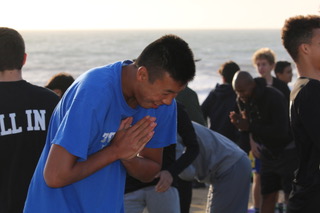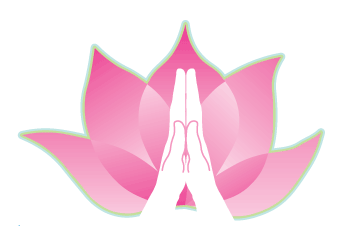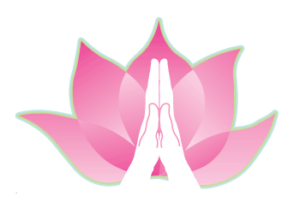
Yoga for Athletes
Taking Your Practice from the Mat to the Court
Last Thursday I was gifted the opportunity to meet with about 50 high school basketball players through West Coast Elite San Diego . WCE is directed by one of the top basketball coaches in the country, Sterling Jones. Sterling trained my son Tommy from the time he was in middle school, and continues to work with him when he is home on break from Harvard.
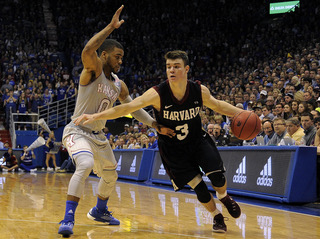
Tommy McCarthy of Harvard VS. University of Kansas
I’ve seen through my children, as well as through my own experience, the kind of camaraderie that forms through the challenges of training. Trust and intimacy evolve naturally as teammates (and coaches) witness one another breaking through mental and physical barriers. You gain a deep respect, and often adoration, for those you see grow, and for those who see you grow through the process.
Paired with camaraderie, however, is often a big dose of competition, extreme rigor and pressure to excel, leaving many athletes overly sore, burnt out, or full of anxiety (which all translate into an impaired game). This is why I’ve found it so important for athletes to supplement their intense training with practices that offer balance, and an opportunity to work – alone or as a team – in a less goal oriented, high pressure way.
Yoga, I’ve found, is the perfect supplement.
So, let’s go back to Thursday when I met with dozens of young, high energy, tight, sore, and rigorous athletes… I came out to help these boys develop greater muscular balance in the body and learn how to discipline their mind through focus and concentration.
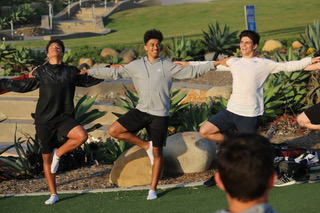
They were all attentive, respectful, and along for the ride. There was also an element of hilarity as they were moaning and groaning with every stretch… But, this just confirmed it even more! Athletes, who are so used to go-go-going strong all the time, need the practice of slowing down and listening.
The result of a balanced approach to training is agility, calmness during stressful situations, ability to move and react quickly, intuitive efficiency, and stronger teamwork!
The boys were extremely receptive to the lessons, and I can’t wait to see how they apply what they learned in their game.
If you are a yoga teacher working with athletes, or an athlete doing your own practice, take these thoughts into consideration:
1. Use Your Breath First : Athletes are often used to moving from their “outer” body first, without much consideration for the feeling or deep rooted cause of the action. In yoga, the movement comes as a result of the breath, so each posture is formed from the inside-out. With long, deep, full breaths you can move deeper into a stretch in a safe way. In most sports the breath speeds up, but in yoga the breath stays slow, even and rhythmic.
2. Find Your Edge : In yoga, “the edge” is the place where you’re working at the top of your body’s ability on any given day. If you worked any less, you’d be slacking off; any more, and you’d be risking injury. Only you know where your edge is, so take the time to listen carefully to what your body is saying from pose to pose. Practicing “the edge” helps athletes struggling to balance ambition in their lives, and can be a potent remedy to the perfectionist mentality.
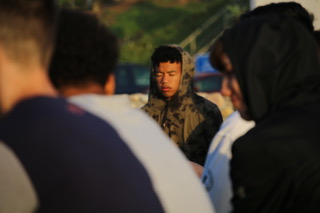
3. Change The Mental State : Many athletes deal with judgment, competitiveness and criticism on a regular basis. This can facilitate and contribute to stress. The yoga practice helps to counter this type of training, as it is deeply personal and should be self enhancing. Yoga is a time to let go of being a goal-oriented competitor and just be present in the process of where you are today.
4. Use Everything, Overuse Nothing : Yoga teaches a balance between Strength and Surrender- both mentally and physically. In the body, for example, notice how you can contract an opposing muscle from the one being stretched, by pulling it closer to the bone. i.e.: contract and lift the kneecap and quadriceps toward the top of the thigh and inward toward the femur to open the hamstrings.
5. Don’t Envy Flexibility / Show Compassion : Flexibility comes to people in varying rates. Some athletes experience a steep learning curve in increasing flexibility. A focused practice of utilizing the breath while stretching muscles may be brand new. These athletes need to be reassured that it takes time and consistent effort to get results. Be careful not to compare flexibility. For many it takes years to achieve a supple, flexible body. It is not easy to be flexible if you train. Training makes you tight! You have to work hard to get tight, so don’t be embarrassed by it.
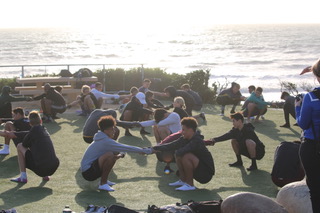
Whatever you play and however you train, I hope you are able to apply these yogic lessons to your practice. There is value in intense training, and value in slowing down. Ultimately, work for balance in your life so that you can play at your highest potential.
Happy practicing!
Stacy
